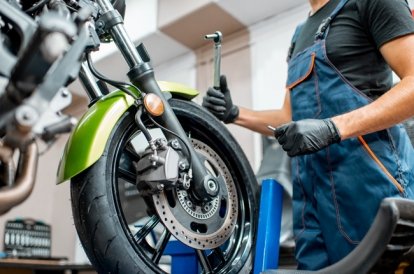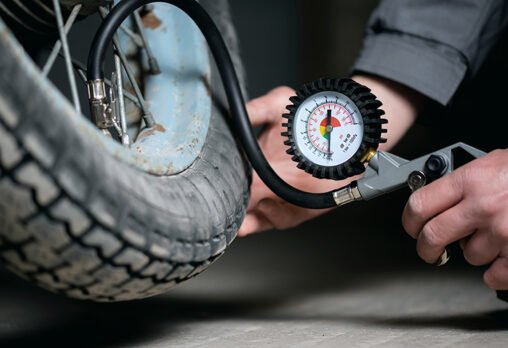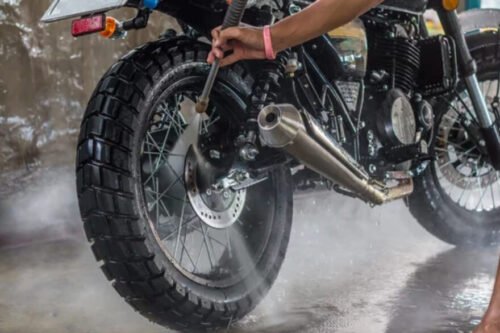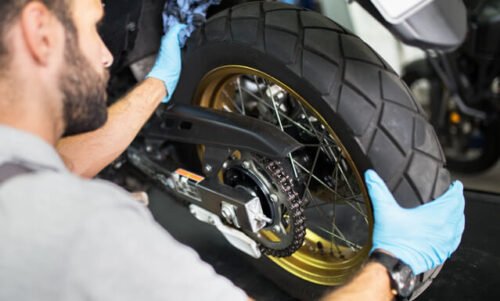Motorcycle safety relies on mirrors for riders to keep tabs on what's going on around them. Yet, not every mirror cuts it the same way. Riders have long been bickering over which is better: bar end mirrors or the stock mirrors. They argue about which (Bar End Mirrors vs Stock Mirrors) gives a better view, […]

Winter Motorcycle Tire Maintenance Tips - 10 Must Dos
Riding a motorcycle in snowy conditions can be a challenge for even the most experienced riders.
Snow, ice, and slush can make the road surface slippery. Slippery surfaces can significantly reduce traction. It can be difficult for the rider to maintain control of the motorcycle.
One of the most critical factors in riding safely in these conditions is the tires. Proper tire care and preparation can make a huge difference between a safe ride and a dangerous skid.
This blog introduces ten essential maintenance tips for motorcycle tires in snowy weather. These tips will help you stay safe, maintain control, and enjoy riding even in winter conditions.
Table of Contents
10 Winter Motorcycle Tire Maintenance Tips
1. Switch to Winter Motorcycle Tires

change the motorcycle tire
Winter-specific motorcycle tires are specially designed to handle snowy and icy conditions. They feature deeper tread patterns and softer rubber compounds that provide better grip in cold weather.
#1. Why Winter Tires Are Important
Winter tires are designed for cold, snowy, and icy weather. Regular tires harden and lose traction in cold weather.
But winter tires are different. They remain soft and flexible at low temperatures. This feature improves their grip on slippery roads.
Winter tires have a unique tread pattern that helps to shed snow, slush, and water. This reduces the risk of hydroplaning. Winter tires have a unique tread pattern that helps shed snow, slush, and water. This reduces the risk of hydroplaning.
Therefore, Winter tires are essential for safe braking, cornering, and control in winter weather. They provide the extra safety and stability you need in adverse conditions.
#2. What to Look For
We should choose tires with the Three-Peak Mountain Snowflake (3PMSF) symbol as winter tires. This means they meet winter performance standards.
We should also choose tires with deep and wide tread patterns that can grab snow and ice while repelling slush and water.
The rubber should be made of a softer compound. Only rubber like this can stay flexible in freezing temperatures to maintain traction. It is also very necessary to make sure the tire meets the size and load specifications of the motorcycle.
Additionally, consider your typical riding conditions (light snow, ice, or slush) to choose the right tire type.
2. Check Your Tire Pressure Regularly

check your motorcycle tire pressure
Cold weather can cause tire pressure to drop, affecting motorcycle handling. Underinflated tire pressure reduces traction. Your motorcycle will be harder to control on slippery surfaces.
#1.Why Tire Pressure Matters
Tire pressure matters because it directly affects your motorcycle's grip, handling, and safety.
Insufficient air pressure increases the area of contact between the tire and the road. This can lead to instability and accelerated wear. Overinflated tires reduce contact with the road. The vehicle will skid more easily, especially on wet or snowy roads.
In cold weather, tire pressure can drop, which can further reduce traction. Maintaining the correct pressure ensures your tires perform optimally, providing better stability, control, and braking, especially in challenging conditions such as snow or ice.
#2. How to Check Tire Pressure
To check tire pressure, use a reliable tire pressure gauge.
First, ensure your tires are cool (check them before riding, as heat can affect the reading). Locate the valve stem on your tire, remove the cap, and press the gauge firmly onto the valve. Read the pressure displayed on the gauge and compare it to the recommended pressure in your motorcycle’s manual.
If the pressure is too low, add air; if it’s too high, release some air. Recheck and adjust until it’s correct, then replace the valve cap.
3. Inspect Tread Depth

inspect the motorcycle tire tread depth with a coin
Tread depth is crucial for maintaining traction on snow and ice. If your tires are worn out, they won’t be able to grip the road effectively, increasing the risk of slipping.
#1. How Tread Helps
Tire tread helps by providing grip and traction on the road, especially in challenging conditions like snow, rain, or mud.
The grooves and patterns in the tread channel water, slush, and debris away from the tire's surface, allowing it to maintain better contact with the road.
In snowy or icy conditions, deep tread improves stability and prevents slipping. Worn or shallow tread reduces traction, making it harder to brake, steer, or stay in control.
Proper tread depth ensures safer, more reliable riding in all conditions.
#2. How to Check Tread Depth
To check the tread depth, you can use a tread depth gauge or the simple “penny test.”
For the penny test, insert a penny into the tire's tread grooves with Lincoln’s head facing down.
If you can see the top of Lincoln’s head, the tread is too worn, and the tire needs replacing. For a more precise measurement, use a tread depth gauge and check multiple spots around the tire.
Tires should have at least 2/32 inches of tread, but deeper treads are safer, especially for snowy or wet conditions.
4. Consider Studded Tires
For extreme snowy or icy conditions, studded motorcycle tires can provide unparalleled grip. These tires have small metal studs embedded in the tread to bite into ice and hard-packed snow.
#1. Benefits of Studded Tires
Studded tires provide superior traction on icy and hard-packed snowy roads.
The small metal studs embedded in the tread dig into the ice, improving grip where regular tires may slip. They reduce the risk of sliding during acceleration, braking, and cornering in extreme winter conditions.
Studded tires are especially useful for riders who frequently encounter black ice or heavily compacted snow. However, they aren’t suitable for dry roads and may not be legal in all areas, so always check local regulations before using them.

studded tires
#2. Things to Keep in Mind
Studded tires are not legal in all regions, so check local regulations before using them. They can wear down quickly if used on dry pavement.
If you frequently ride on icy roads, studded tires are a worthwhile investment to increase safety.
5. Warm Up Your Tires Before Riding
Cold tires are less effective at gripping the road, as the rubber becomes stiff in low temperatures. Warming them up before riding can improve traction and handling.
#1. How to Warm Up Your Tires
To warm up your tires, start your ride slowly.
We should also avoid aggressive movements like sudden braking or rapid acceleration. For the first few miles, we should ride gently to generate heat through friction. As the tires warm up, flexibility and grip will improve.
In colder weather, this process takes longer, so be patient. If you are preparing for a long ride or a race, you can use a tire warmer.
A tire heater is an electrically heated wrap. It warms up the tires before you start riding, ensuring peak performance from the start.
6. Avoid Sudden Movements

Sudden movement may cause motorcycle accidents in the winter
Snowy roads are unforgiving when it comes to sharp or sudden movements. Even the best tires can lose grip if you’re not riding smoothly.
#1.Smooth Riding Tips
- Accelerate gradually to avoid spinning the rear tire.
- Use gentle inputs when steering to prevent the front tire from losing traction.
- Brake smoothly and evenly, applying more pressure to the rear brake.
- By staying calm and riding smoothly, you give your tires the best chance to maintain traction.
7. Reduce Speed and Increase The Following Distance
Snowy conditions require slower speeds and more caution. Riding too fast or following too closely will shorten your reaction time and increase the likelihood of slipping.
#1. Why Speed Matters
High speeds reduce the time your tires have to grip the road. Slowing down gives you more control, especially when cornering or braking.
Speed matters because it directly affects your ability to maintain control.
Riding too fast reduces the time your tires have to grip the surface and increases the risk of slipping or skidding. High speeds make it harder to brake safely or steer smoothly, especially in poor traction conditions. Lower speeds can increase reaction time and reduce the likelihood of accidents.
#2. Tips for Safe Riding
- Ride at a slower speed than usual to account for reduced traction.
- Maintain at least twice the usual distance between you and the vehicle ahead.
- Reduce your speed and increase your following distance to give your tires more time to react to the road.
10 Motorcycle Winter Riding Tips: Stay Safe and Warm 2024
8. Avoid Riding in Deep Snow
While winter tires can handle light snow, deep snow can overwhelm even the best tires. Riding in heavy snow increases the risk of getting stuck or losing control.

riding in deep snow
#1. Why Deep Snow Is Dangerous
Deep snow is dangerous because it reduces friction, drastically reducing traction.
The buildup of snow around the tires can clog the tread, making it harder for the tires to grip the surface. This increases the risk of slipping, losing control, or getting stuck. Deep snow also hides hazards like ice, potholes, or debris, making riding unpredictable.
For safer riding, stick to cleared or well-maintained roads and avoid venturing into deep snow whenever possible.
#2. What to Do
- Avoid riding in deep snow whenever possible.
- Stick to cleared or salted roads for better traction.
- By avoiding deep snow, you reduce the strain on your tires and improve your chances of staying safe.
9. Clean Your Tires After Riding

clean motorcycle tire entirely
Snow and ice can leave behind debris, salt, and dirt on your tires, which can affect their performance over time. Cleaning your tires after every ride ensures they stay in good condition.
#1. Why Cleaning Matters
Road salt eats away at the rubber, weakening the tire structure and shortening its life. Dirt and debris clog the tread, reducing traction.
Regular cleaning ensures your tires maintain optimal grip and performance. By keeping your tires clean and free of buildup, you enhance their durability and improve safety during winter riding.
#2. How to Clean Your Tires
Use warm water and a gentle brush to remove snow, salt, and dirt. Dry the tires completely to prevent freezing or cracking. Regular cleaning keeps your tires in top shape and ready for the next snowy ride.
10. Replace Old or Worn-Out Tires

an engineer is replacing a motorcycle tire
Even if your tires seem fine, they may not perform well in snowy weather if they’re old. Over time, the rubber hardens and loses its ability to grip the road.
#1. When to Replace Tires
Tires should be replaced when their tread depth falls below the minimum safe level.
Most tires are typically 2/32 of an inch deep; for snowy conditions where deeper tread is required, they should be replaced sooner.
If a tire shows visible damage, such as cracks, bulges, or cuts, it should be replaced as soon as possible. Failure to replace the tire promptly can compromise safety.
Age is also a factor - most tires should be replaced every 5-6 years, even if they appear to be in good condition. Old, worn, or damaged tires lose grip and traction, increasing the risk of skidding, especially in winter.
#2. Why It’s Important
Old tires are less effective at gripping snow and ice, increasing the risk of slipping. Replacing them ensures you have the best possible traction for safe riding. Investing in new tires when needed is a simple yet essential step for winter safety.
Conclusion
Riding a motorcycle in snowy weather is no easy task, but with the right tire care and preparation, it can be done safely. The ten motorcycle maintenance tips for winter days will help you maintain control and reduce the risk of skidding.
Remember, your tires are your lifeline on the road, especially in winter conditions. Regular inspections and maintenance are not only for your motorcycle’s protection but also for your own. Ride safely and enjoy the unique experience of winter motorcycling with confidence!

Rodney L is a technical writer and product consultant with over a decade of experience in the motor industry. Rodney is a fan of performance machines that run fast and loud and an expert in all things custom. His numerous articles and write-ups are available at our knowledge base. Whether it’s something wrong with your motorcycle or you are building a custom bike, you can trust Rodney’s experience.
Picking the perfect brake pads for your ride has an influence on how safe you are, how well your whip handles, and what you’ll shell out over time. You’ve got a whole menu, from wallet-easy organic pads to fancy ceramic or semi-metallic types. To get why budget brake pads ain't the same as the pricier […]
E-bikes have transformed into more than just gadgets to help you get around. Now, they're speed demons that can go toe-to-toe with motorbikes. It’s 2025, and these speedy machines have gotten a huge boost from better motors, more powerful batteries, and sleek designs that cut through the air like a knife. Let’s dive into the […]
Many riders who aren't so tall or ladies just starting to ride bikes need to pick out the best Motorcycles for Short Riders and Women. They gotta look for three key things: a seat that's not too high up, a bike that's not too heavy, and something that looks good enough to give them confidence. […]
As we accelerate into 2025, motorbikes are getting a serious tech upgrade. They’re all about safer rides and more fun on the road. Even if you’re a pro or just starting, kitting out your two-wheeler with cool tech stuff is a game-changer. Check out these ten top motorcycle gadgets each motorcyclist will want in 2025. […]
Getting around the city every day can be super annoying. You've got traffic like molasses nowhere to park, fuel prices through the roof, and buses stuffed like sardine cans make heading to the office a real pain. For loads of folks, getting a motorcycle is a pretty slick move—they’re nimble, cost-effective, and perfect for squeezing […]


This blog is super helpful! Keeping tires in good shape is key to a smooth, safe ride, and the advice on rotating and balancing is spot on.
Great tips! Taking care of your motorcycle tires is so important for safety and performance. Regular checks and proper pressure can make all the difference on the road.